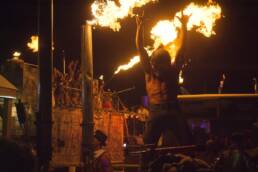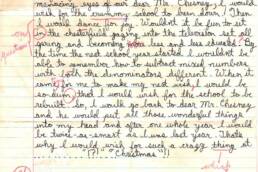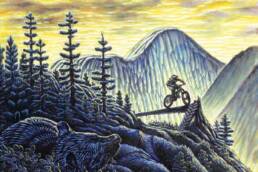Every Labour Day long weekend, a prehistoric lakebed in northern Nevada plays host to an audacious mass of human creativity and celebration of spirit. Some 70,000 followers from around the world travel to Burning Man, including one of our own. Pantless and without judgment, KMC’s Mike Berard turns high-as-hell hoser and tries to find the faith.
“See, your problem is that you brought too many expectations to Burning Man,” says the man with the cigarette. We’re standing outside the Temple, a beautiful, colossal, 100-foot-high all-wooden structure built in reverence and remembrance to lost friends and the struggles of the past year. It is viewed as a place of great respect. So, not surprisingly, I’m confused. Why is this guy being such a dick? The past few days have been a blur of joyful meetings with new friends, long bike rides and the entirely unique feeling of letting all judgment fall away. That’s what Burning Man is about. At least it seems to me. You give and receive, walk freely in your own skin, so why then am I being ostracized?

I had asked Cigarette Man directions to Robot Heart, the New York City-based mobile art installation that doubles as one of Burning Man’s most popular dance clubs. His reaction is to tell me that I should not be seeking one particular experience but instead let Burning Man wash over me in whatever way it chooses to. I am wearing nothing but a captain’s hat, sneakers and a sport coat. It makes the sudden smack of judgment seem like it should be all the more hurtful, but I am at Burning Man. It’s different out here. I let his judgment fall off my back and down my naked ass as I ride my bike into the desert, off to find whatever waits for me out there.
Although I am begrudged to say it, Cigarette Man makes a good point. The only preconceived plan I came to the Nevada desert with was to seek out a friend from Whistler. I know what camp he’s staying at. I know what time that camp is having a party. But somewhere along the half-kilometre bike ride to get there, the lights and music of the Black Rock Roller Disco pull me away. For the next 45 minutes, I gingerly balance on roller skates under the night sky thanks to the stable arm of a helpful man named Ricardo. We are awarded Best Couple. I never ended up speaking to my friend until my return to Whistler.
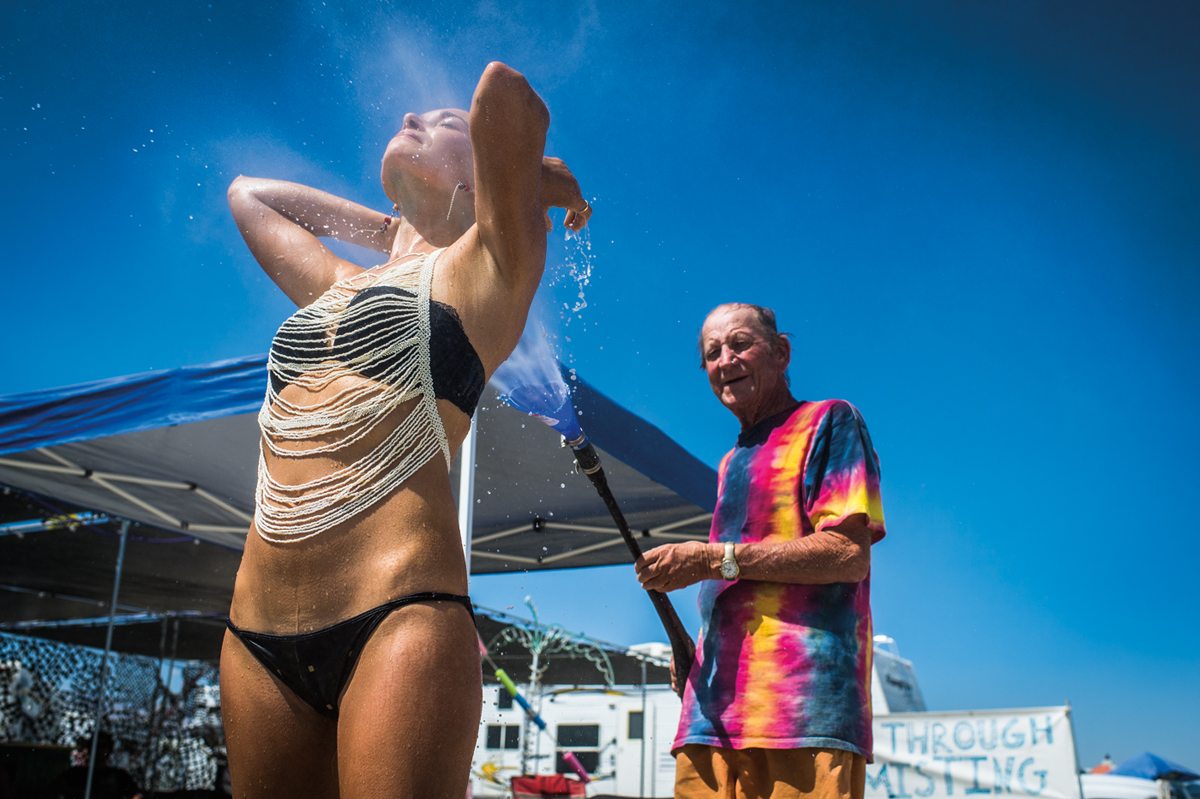
That’s the thing about Burning Man. It’s like swimming through a dump truck full of jelly beans and someone tells you there’s a really cool jelly bean in there somewhere. Do you seek it out, or just open your mouth and keep breaststroking into bliss?
Speak to veteran burners and you’ll be told it is unique to each person. “it’s whatever you want it to be.” it can be an eight-day long party. Or a pansexual extravaganza.
Surprisingly, there aren’t that many hippies at the week-long desert art installation slash festival. Sure, if you search hard enough you will find dreadlocks and the crunchy granola types more often found in the Kootenays or Gulf Islands.But this annual experiment in creative humanity is more closely aligned with the upper middle class of the San Francisco art scene that created it. Black Rock City, the temporary, half moon-shaped settlement on the desert — referred to as “The Playa” — plays host to nearly 70,000 of these people for eight days. The idea that it’s a giant, long-haired love-in is only one of Burning Man’s many myths.

100-foot-high statue built every year and the event’s namesake, is ignited and destroyed, setting off the week’s biggest night of celebration
Although the inaugural Burning Man took place in San Francisco in 1986 with 20 participants, the first time I’d heard about Burning Man was in a 1996 Bike Magazine article that painted the annual gathering as a community of freaks, focusing on the tie-dye-tinged sex, drugs and lunacy of art fringe. As I watched the movement grow steadily over the following 15 years, so did the myth that comprises most people’s view of this misunderstood event.
So let’s start by dispelling some bullshit:
- There are no — or very few — clichéd hippies. It is an incredibly diverse crowd of people.
- It is not a rave. Repeat. It is not a rave.
- There is no “trading” economy. People simply gift each other. . . constantly.
- Not everyone is on drugs, naked and having sex indiscriminately. Although, this is happening.
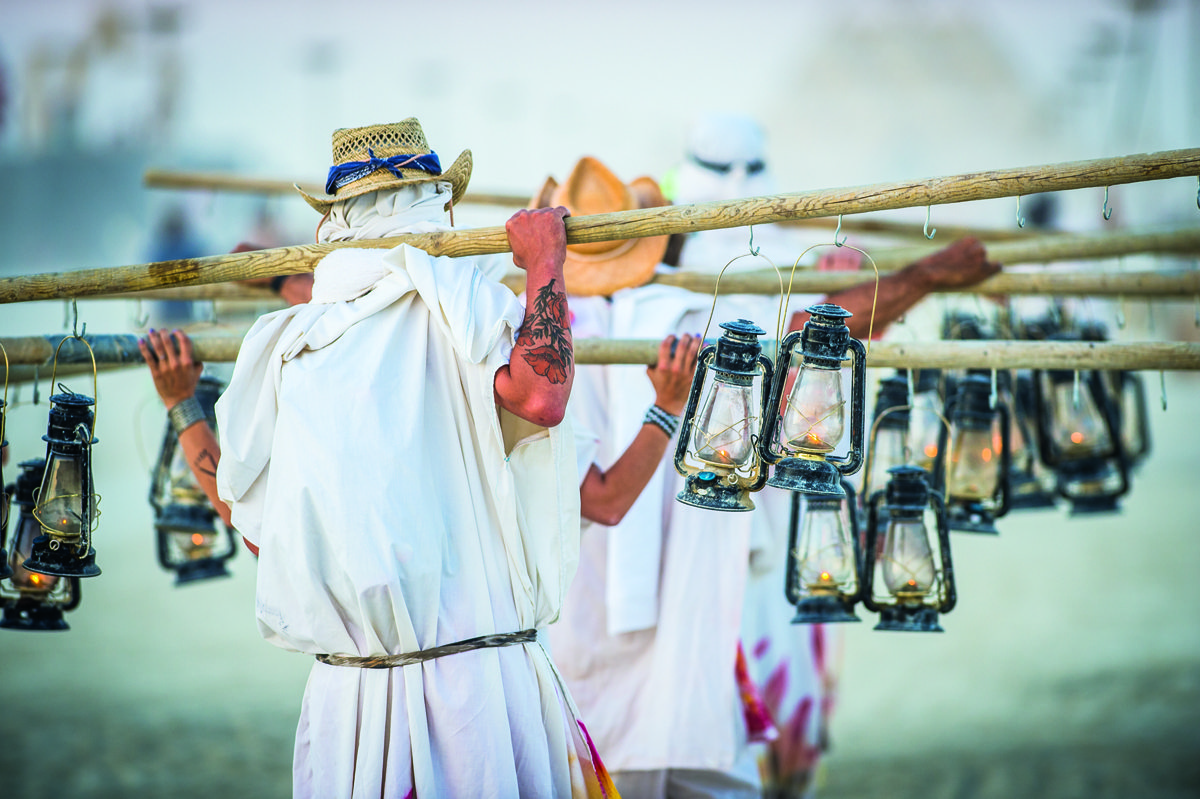
To say what Burning Man is not is easy. To say what it is can be a trickier exercise. Although Burning Man may not be easily explained, it can be described. Simply put, it’s a temporary city in the desert, surrounded by art installations. No cash is exchanged. You can buy coffee and ice and nothing else. Gifts of all manners — from food to experiences to wisdom — are given. Everyone rides bikes. No dogs or firearms are allowed. All lifestyles are welcome, and that means all — not just the happy ones. Nudity and joyfulness are common. Everyone arrives looking for something different, and everyone receives it.
Speak to veteran Burners and you’ll be told it is unique to each person. “It’s whatever you want it to be.” It can be an eight-day long party. Or a pansexual extravaganza. Or an exploration of the modern art scene. Or a simple camping trip in the desert. You make Burning Man whatever you want it to be. I arrived looking for something I couldn’t quite explain.
It’s like swimming through a dump truck full of jelly beans and someone Tells you there’s a really cool jelly bean in there somewhere. Do you Seek it out, or just open your mouth and keep breaststroking into bliss?
Watching a church burn is a trip. Watching it whilst ripped out of your gourd is another thing. From the top deck of Dang Gang, a double-decker bus customized into one of the hundreds of “art cars” that populate the nighttime landscape of The Playa, you can see a kaleidoscope of light moving fluidly through the blackness in every direction. It’s like Vegas — if Vegas worked on a cash-free and kindness-rich economy. Earlier, The Man, for which Burning Man is named, was lit up in a blaze of towering orange and revelry, kicking off the biggest party night of the week. And now a giant crowd of people watches five men and a woman approach a gothic church with flamethrowers. The crowd cheers as they bathe it in flame. After a while the church crashes down, undermined by fire. When it’s finally reduced to ashes, the crowd disperses but we don’t. The art car has broken down. We wait. Cops tackle a man, cuff him and drag him away. And then the dust storm arrives with a fury.
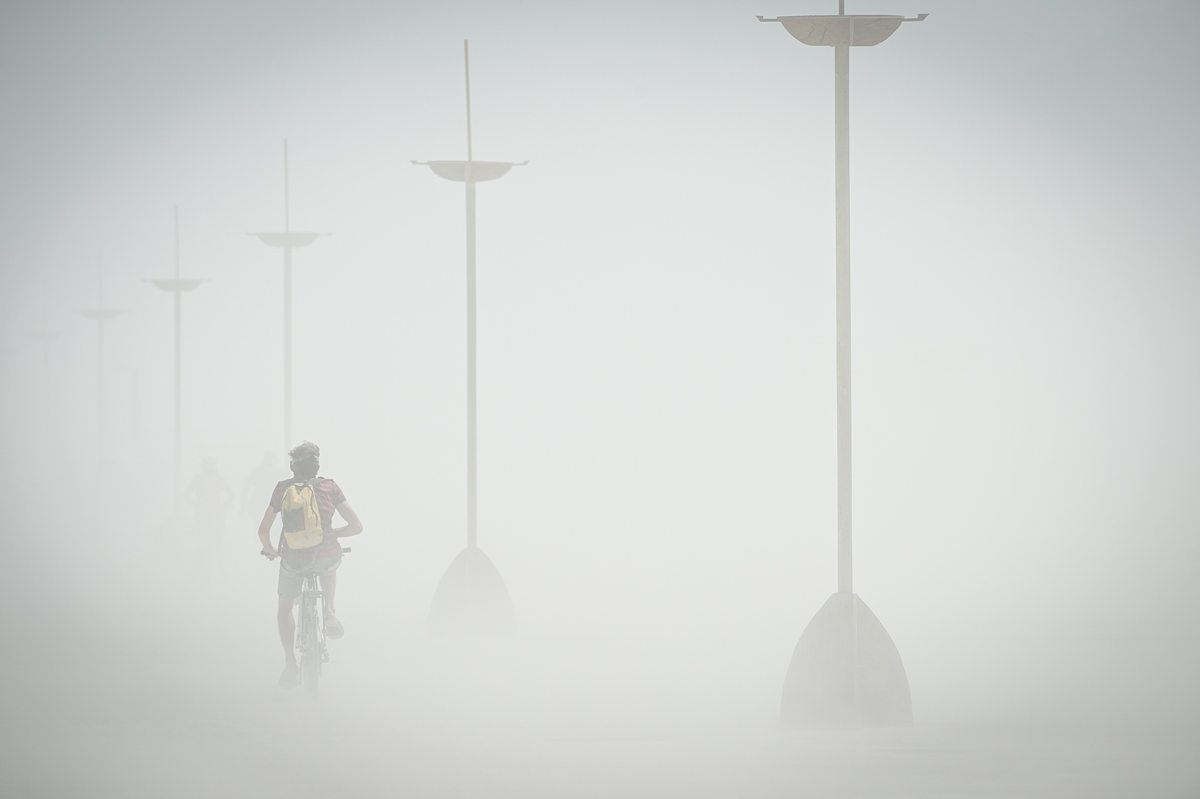
Perhaps the most infamous of Burning Man’s peculiar idiosyncrasies, the dust storms that roll over the dried-up lakebed and assault the city are a hallmark of desert living. Prepared Burners don bandanas, dust masks and ski goggles to shield the storms, which are capable of enduring for days on end but mostly last less than an hour. From my location, walking back to the city means getting lost in the impenetrable storm. I am stationary for the duration, drinking 18-year-old Scotch and rolling the thought over in my mind: what does it mean to burn a church? Woah.
Hours later, I stand on the upper prow of Dang Gang, arms outstretched as the great vehicle lumbers through the dust; it’s repaired, redeemed and radically altered. Together we are glorious.
The temple is alive. Within it a slow-moving and silent congregation of people have gathered. Some meditate or pray. Others meander their way through the ornate wooden building, reading the millions of words written upon the walls. Photos and mementos of lost friends and family have been pinned and taped to every conceivable square centimetre. Some are even dedicated to lost pets. In the center sits a giant black stone formation. People lay hands upon it.
I’ve come to the Temple with a friend to recognize his struggle; the past month brought him a terrifying diagnosis of testicular cancer and the subsequent loss of one nut. With his back to me, he reaches high and tapes his hospital bracelet to a small piece of available wall space. When he turns around, the catharsis is evident in his tears. It is at once both astounding and just one more tiny moment in this vibrant place of healing. As we weave our way to the temple’s exit, we pass a dozen other groups going through the same exorcising of pain carried too long.
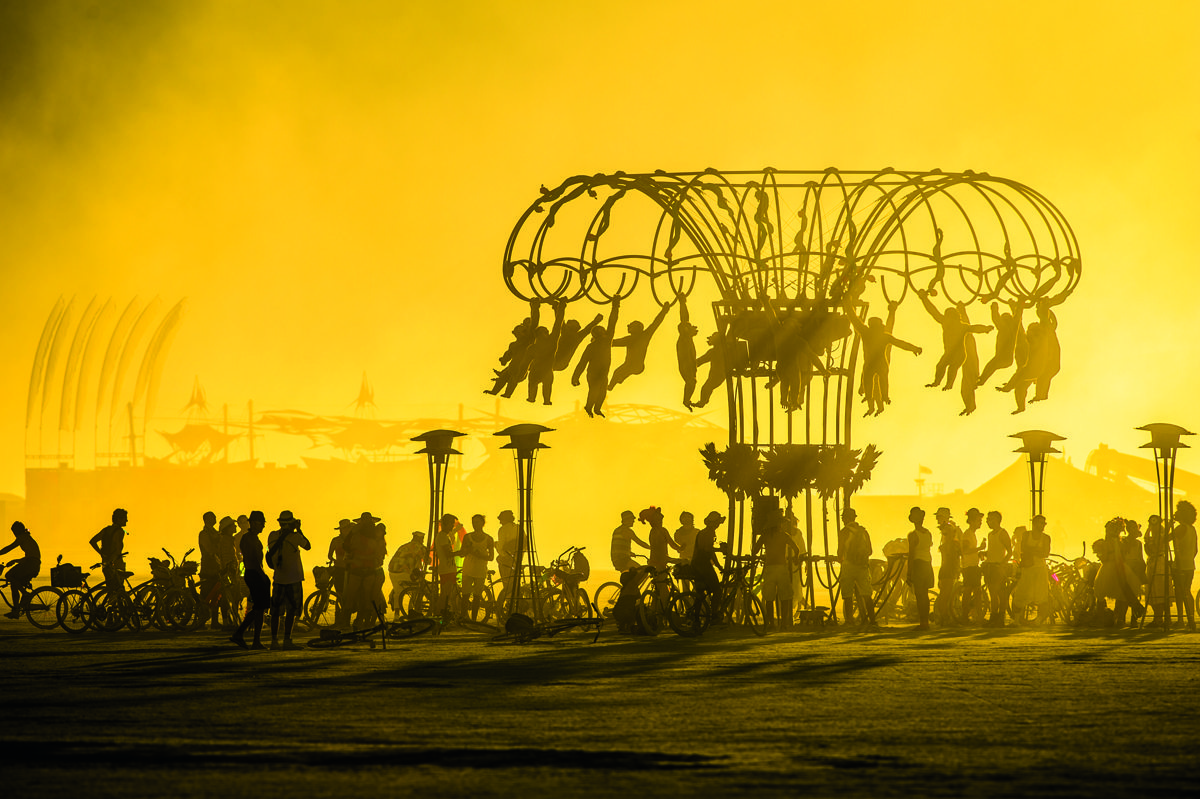
You can’t explain Burning Man. I’ve been told this a thousand times by friends who’ve gone before me. Media reports have reinforced it, more often than not inaccurately referring to Burning Man as an arts festival or an Ibeza-esque club scene. And it’s understandable. When you Google photos of naked or flamboyantly costumed happy people and hear third-hand stories of drug-fuelled orgies in giant tents, you will inevitably be led to a certain image — one that Burners would strive to correct if it weren’t a significant part of the journey. But like most things, you have to do the work to truly understand the depth of this 28-year-old phenomenon.

Like all good things, Burning Man doesn’t come easy. If it did, it would cease to be a week-long exploration of personal ideology. If it were held on a sunny, green lakeshore, it would invite the people solely looking for MDMA and all-night dubstep. With dusty impunity, The Playa chokes out those who seek easy partying. The strange kindness of this temporary community tempers those who come to take advantage of its riches. It transforms people. Doubt it? Just ask someone who has been to Burning Man if you have plenty of time and the headspace to listen to the answers. I was changed. And because it’s hard to explain Burning Man in general, you can appreciate that communicating your own transformation is perplexing.
I arrived looking for something I couldn’t quite explain. I found so much more.
Related Stories
Simon Beck Stomps Out Art
In 2012, we covered Simon Beck's incredible snowshoed artwork in KMC. Recently, Icebreaker released a video of his…
Art Director’s Christmas Wish
Chris Rowat, KMC's Art Director, is a very talented man. If not quirky and perhaps ecclectic, like any creative…
KMC Editor’s Intro: Science is Art is Science
In his editor’s introduction of the March 2015 issue of Canada’s The Walrus magazine, John MacFarlane bids readers…


